
Table of Contents
Suppose you represent a multi-departmental or global company with complex data needs. In that case, you have probably heard the term Master Data Management (MDM) before or even contemplated choosing between open-source and proprietary MDM solutions. Yet before comparing open-source and proprietary MDM, it’s critical to have a solid understanding of what it actually is, including its purpose, functionalities, and your organization's specific needs.
What is MDM
Master Data Management (MDM) software are the tools and processes businesses use to manage, monitor, and secure all the important data, including product, customer, supplier, and other key data domains. MDM software allows businesses to:
- Provide data security and protect sensitive and organizational data from unauthorized access.
- Enforce standards and policies for data quality and compliance.
- Streamline data integration, updates, and accessibility across systems.
The common features of MDM software include:
- Integrating data from various sources into a centralized MDM system, often through APIs, automated processes, or bulk uploads.
- Defining and applying rules for data consistency, integrity, and security.
- Standardizing, cleansing, and validating data to eliminate duplicates and errors to ensure data consistency.
- Tracking data usage, lineage, and accuracy.
- Implementing controls like role-based access and encryption to protect sensitive information.
- Ensuring that data adheres to organizational and regulatory requirements.
- Generating logs, dashboards, and reports for proper data analytics and governance.
Simply put, MDM software provides organizations with a single source of truth for their data. This leads to better decision-making, regulatory compliance, and operational efficiency.
Who Needs MDM Software?
While MDM is dedicated to managing critical business data, whether a company needs it depends on a few key factors: Data Ecosystem Complexity Companies that handle massive volumes of data across numerous systems, departments, and regions would greatly benefit from MDM software. These businesses typically generate massive amounts of data from various sources like ERP, CRM, E-commerce platforms, and PIM systems. This creates the need for consistent data integration where MDM also comes in handy. Serving as the centralized data hub, MDM ensures uniform data formats and naming conventions across systems. Modern MDMs are designed to integrate with external platforms. This brings consistent data sharing and updates in real time.
Data Dependency
Businesses of certain industries need MDM more than others. For example, Retail and E-Commerce businesses constantly must centralize product information, inventory, and customer data across multiple sales channels. They are also expected to ensure consistent pricing and descriptions across stores and platforms. Businesses from the healthcare industry also often turn to MDM since the data standards of the industry are very high, and mistakes are extremely undesirable. MDM helps businesses in healthcare maintain accurate patient records and ensure regulatory compliance. Businesses from Banking and Finance industries are one more common client for modern MDM vendors. They usually need to integrate customer data, risk records, and compliance information, while facilitating accurate reporting and improving fraud detection. MDM software can satisfy all these needs. Other MDM industries that typically need dedicated MDM software include Manufacturers and Supply Chain businesses, Energy and Utilities, Technology and Telecommunications, Logistics and Transportation, and more.
Growing Pace
Rapidly scaling businesses with increasing data complexity requires MDM to prepare for future expansions without data chaos. As businesses add new platforms (e.g., ERP, CRM, or e-commerce systems), inconsistencies in data formats and standards often arise. In this case, investing in MDM at the early stage of business growth is the smart strategy.
Simply put, your business does need MDM if you:
- Face data quality issues: inconsistent, duplicated, or inaccurate data across systems.
- Deal with multiple data sources and need to integrate data from numerous platforms or tools.
- Requiring unified data for analytics, compliance, or operational decisions.
- Operate in the industry with strict compliance requirements such as Healthcare and Banking, etc.
Benefits of Open-Source MDM solutions
What is Open-Source MDM
Open-source Master Data Management (MDM) software refers to MDM platforms whose source code is freely available. This allows businesses to customize and manage master data solutions without relying on proprietary vendors. These tools are often cost-effective and highly adaptable.
Total control over your data
Relying on open-source master data management solutions, businesses own their data. Using a proprietary cloud-based MDM solution, on the other hand, might pose challenges in transferring or copying a company’s master data if they decide to quit the MDM service.
Cost Saving
Open-source MDM solutions provide access to source code free of charge. This gives businesses and organizations with IT teams the ability to modify and customize the solution according to their needs. This might be significantly cheaper than relying on proprietary solutions with subscription fees and licensing costs, while also offering greater flexibility to adapt the system to unique business processes or requirements.
Flexibility and Customization
Since Open-source MDM software has open-source code, businesses can modify this code and tailor the system to fit their specific needs. This allows businesses to create custom workflows, tailor data models, or add integrations with proprietary or legacy systems. Unlike proprietary solutions, where features and updates are controlled by the vendor, open-source tools make it possible for businesses to build functionalities not available out-of-the-box.
For example, a retail company can customize an open-source MDM tool to handle complex multi-channel product data synchronization across global e-commerce platforms and in-store systems. Proprietary systems can also handle multi-channel data synchronization through vendor-provided features or customizations. However, they often come with higher costs, limited flexibility, and dependency on the vendor for updates and changes.
Community-Driven Innovation
MDM is a relatively niche field compared to broader open-source software categories, like content management systems or programming frameworks. Therefore, their community-driven innovation is typically not as extensive or fast-paced as it is for more mainstream software. However, while the MDM communities themselves are smaller, it is often composed of highly specialized professionals addressing niche MDM challenges.
Transparency and Security
With open-source MDM, the source code is fully visible. This provides transparency into how the software operates and ensures there are no hidden vulnerabilities or backdoors. As a result, businesses can independently audit the code for security, compliance, and performance, addressing any specific concerns.
Integration with Existing Systems
The ability to integrate with other systems lies at the core of MDM software. Limited flexibility and high costs associated with licensing, and add-ons are the common challenges that proprietary MDM pose when it comes to integration with external software.
Open-source MDMs offer greater flexibility and customizability for integrations compared to proprietary solutions. Open-source MDM is fully customizable and allows businesses to create tailored integrations for unique workflows, niche systems, or proprietary platforms.
Best Open-Source MDM Solutions
AtroCore
AtroCore is a flexible and modular open-source platform designed for managing data and workflows efficiently. It serves as a centralized hub for organizing and enriching product data, digital assets, or other information types. With its highly customizable architecture, AtroCore is ideal for businesses seeking tailored solutions for data management and collaboration. AtroCore has the ability to integrate seamlessly with other MDM solutions such as Talend Open Studio, allowing complex data transformations to occur within Talend while ensuring the processed data is readily available in AtroCore for efficient management and further enrichment.
Talend Open Studio
Talend Open Studio is a free, open-source ETL (Extract, Transform, Load) tool used for data integration and transformation. Its drag-and-drop interface and extensive library of connectors enable users to link various databases, cloud platforms, and third-party tools for seamless data workflows. Talend specializes in handling complex data transformations and automating data pipelines. It can be integrated with systems like AtroCore to preprocess and prepare data, ensuring AtroCore users work with clean, structured, and enriched datasets, thus enhancing the overall data management process.
Pimcore
Pimcore is an open-source digital platform that combines product information management (PIM), digital asset management (DAM), and content management system (CMS) functionalities. It is widely used for managing and distributing product data across multiple channels and is particularly valued for its robust support for omnichannel marketing and e-commerce. Pimcore emphasizes a broader scope, integrating not just data management but also content delivery and customer experience tools. Pimcore’s primary focus lies in delivering data and assets effectively to end-users or customers.
Solution Overview
| Solution | Best Suited For | Integration Capabilities | Modules | Key Features | Licensing and Support |
|---|---|---|---|---|---|
| Talend Open Studio | Small to medium-sized businesses looking for an open-source ETL tool with basic MDM-like functionality and data integration capabilities. | Integration with databases, cloud platforms, and third-party tools is mostly easy due to Talend's drag-and-drop interface, prebuilt connectors, and real-time validation. Configuring properties and using cloud-native APIs simplifies the process. Advanced custom workflows or complex scenarios may require Java scripting or deeper technical knowledge. | Doesn’t have modular add-ons. Enterprise offerings include modular capabilities for data quality, governance, cloud, big data, and API management as part of broader subscription plans. | Data integration, data transformation, and basic MDM functionalities. Advanced MDM capabilities are available in the proprietary enterprise version. | Free (open-source basic version) license. Paid enterprise version for full MDM. |
| AtroCore | Businesses that require a highly configurable, lightweight, open-source Master Data Management (MDM) solution, especially for managing product data in retail, e-commerce, and manufacturing. | Has own powerful API with 100% functional coverage incl. for custom configurations. Offers native integration solutions for many ERP and e-commerce systems. | Extensible with free and paid modules. | Centralized master data management, customizable workflows, multi-language support, and highly flexible data modeling. | Free (open-source) license. Support package can be purchased additionally. |
| Pimcore | Companies in e-commerce, retail, or manufacturing that need a comprehensive solution combining MDM, Product Information Management (PIM), and Digital Asset Management (DAM). | Strong API for integration with any kind of third-party software. Integration solutions are offered by solution partners. | Extensible with paid modules. | One integrated solution with support for MDM, PIM, DAM, and CMS. Other features: advanced data modeling, multi-channel publishing, and customizable workflows. | Free (open-source) license without support. Paid enterprise license, support is included. |
Key Takeaways
Master Data Management (MDM) is essential for businesses handling complex and diverse data ecosystems, particularly in industries with strict compliance requirements or rapidly growing operations. Open-source MDM solutions offer significant advantages, including cost savings, customization, flexibility, transparency, and greater control over data. For organizations with technical expertise and resources to manage and customize open-source tools, these solutions can be a powerful alternative to proprietary options. Ultimately, the choice between open-source and proprietary MDM depends on a company’s specific data needs, integration requirements, and long-term growth strategies.


